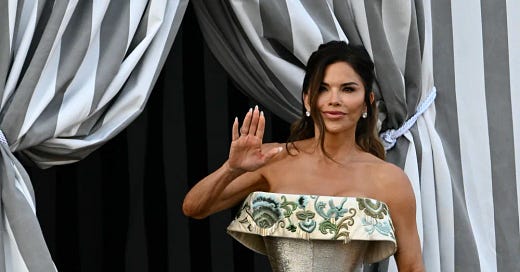When I saw the photos of celebrities stepping on and off Venetian boats at the Bezos wedding—Lauren Sánchez Bezos’ sinewy, muscular arms on full display—I had so many thoughts.
First: how fascinating that visible muscle on a woman’s upper body has become a new symbol of power and beauty. I don’t think we’ve ever seen that much muscle on a highly-photographed socialite. I could be wrong. In any case, it appears regular old thinness is more attainable now. Ozempic has become ubiquitous, and GLP-1s are readily available at a health spa or gym near you. Skinny arms are affordable. But building and showing muscle? That takes time, discipline, and delayed gratification. What a power flex: Balenciaga plus biceps.
Lauren Sanchez Bezos says she works out and watches what she eats. In an interview with Vogue at her dress fitting, she told reporter Chloe Malle that she lost three and a half pounds for the big day, avoiding alcohol and cutting down on salt. “Some people meditate, I work out,” she said. She has posted on Instagram about upper-body exercises with trainer Wes Okerson and credited Pilates with transforming her posterior.
But here’s the uncomfortable truth: achieving that kind of definition requires very low levels of body fat. I know, because in a few weeks, I’ll be there myself.
To build muscle, you need a calorie surplus—at least 200–300 calories over your maintenance calories per day if you want real, steady gains. But to see that kind of muscle clearly, what we call definition, you have to strip body fat dramatically. A healthy range of body fat for most women is about 20–30 percent, depending on age and build. Athletic women like me typically hover around 15–20 percent. Right now, I’m at about 16 percent body fat: I look strong, healthy, and well-fed. People often comment on my arms. I look like I could swing a sledgehammer. But my arms don’t have that sinewy, ballerina-like look Lauren showed off.
Lauren’s body, like many celebrity bodies, requires relentless attention to diet. When I step on stage to compete, I’ll lean down to around 10 percent body fat so judges can see every muscle striation. I’ll look about like Lauren. But getting there is grueling: I measure every gram of food, meticulously balancing carbs, proteins, and fats, cycling carbs up or down by the day. I’ll follow my coach’s training program to a T. I’ll reach that Bezos-level physique—or leaner—but it’s for an extreme sport. It’s not how I live most of my life. After the show, my coach and I will focus on bringing my body fat back up to healthier levels that are sustainable.
For my book, I interviewed Dr. Brooke Whisenhunt, a psychologist who studies body image and the rise of the “skinny-muscular” ideal. Her 2017 research at Missouri State University found that Miss USA contestants from 1999 to 2013 became thinner and more muscular—and those changing bodies were increasingly rated attractive by young women. In a follow-up study, participants viewed photoshopped images of thin models with added muscle. While both versions were rated attractive, when forced to choose, participants preferred the more muscular look.
This isn’t body positivity; it’s a new, even more punishing standard. As Dr. Whisenhunt told me: “It’s particularly insidious because it’s promoted under the guise of health.” The fitness and diet industries seize on this, selling supplements, boutique studios, and “long and lean” workouts promising a sculpted-yet-waifish body.
Don’t get me wrong: I love muscle. It changed my life. I love the pageantry of a bodybuilding show, with its colorful bikinis, ripped bodies, big hair, and spray tans. But that’s for a specific moment in time — and then it’s over. Muscle, most of the time, is meant to live under a healthy layer of fluff. Pursuing permanent “stage lean” definition isn’t just unrealistic; it’s dangerous.
The wedding images from Venice — people being assisted on and off boats in tiny bra tops and flowy pants — are signals and symbols that the rest of us ogle, and interpret, and what our daughters imitate in their TikTok videos. (My 14-year old daughter, who recently opened a TikTok account, now tells me she wants “abs.”)
I don’t want my 14-year old to want abs. I want her to eat.
And I think about this, and my bodybuilding shows and Lauren’s arms. And as their yachts putter along and the public tosses mannequins into the river in protest, one thing is clear: the rich don’t always get it right.
Even when their arms look perfect.





The only way to achieve what she has, at her age, is to pay big bucks for a personal trainer and dietician and chef and to make your personal image your main work to the exclusion of all else.
This is such an important article. I didn't really have any idea how this look was achieved and now I realise that for mere mortals like me, 59 years old, strength training 3 times a week, living a normal life, I can't attain this. It's enough to be strong, fit and capable